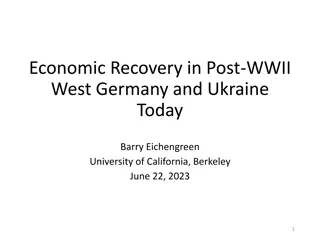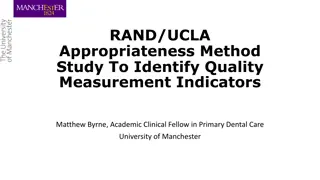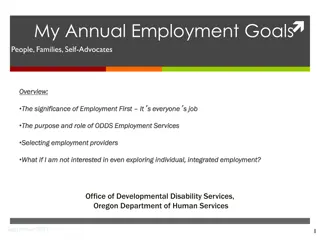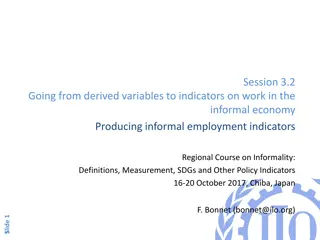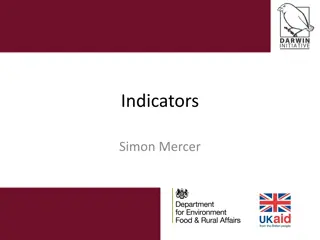Measurement of Quality of Employment Indicators in Ukraine
This presentation discusses the sources and analysis of quality of employment indicators in Ukraine, highlighting key findings from 2017-2021 and prospects for development. It explores available data sources, labor market indicators, and the impact of recent laws on reporting during times of conflict.
Download Presentation

Please find below an Image/Link to download the presentation.
The content on the website is provided AS IS for your information and personal use only. It may not be sold, licensed, or shared on other websites without obtaining consent from the author.If you encounter any issues during the download, it is possible that the publisher has removed the file from their server.
You are allowed to download the files provided on this website for personal or commercial use, subject to the condition that they are used lawfully. All files are the property of their respective owners.
The content on the website is provided AS IS for your information and personal use only. It may not be sold, licensed, or shared on other websites without obtaining consent from the author.
E N D
Presentation Transcript
Measurement of quality of employment indicators in Ukraine: Current Status and Prospects for Development lla S lop State Statistics Service of Ukraine Meeting of the Group of Experts on Quality of Employment Geneva, 14-16 May, 2024
Contents 1. Information sources for measuring the quality of employment in Ukraine. 2. Main results regarding the assessment of quality of employment n Ukraine for 2017-2021. 3. Availability and use of quality of employment indicators. 4. Prospects for Development.
nformation sources for measuring the quality of employment in Ukraine The main information sources for measuring the quality of employment in Ukraine are as follows: - Labour Force Survey and ad hoc modules; - Enterprises surveys related to: labour statistics; labour conditions at enterprises (is conducted every two years); structure of earnings (SES) (is conducted every four years); labour cost (is conducted every four years); occupational injuries; -Admistrative data of the Social Insurance Fund of Ukraine, Pension Fund of Ukraine and other.
The presentation includes an analysis of available indicators in accordance with the Handbook on Measuring Quality of Employment (UNECE, 2015), which can be used to measure the quality of employment in Ukraine. Special attention is focused on some dimensions. The presentation gives the latest information on the quality of employment indicators for 2021. In line with the norms of Ukrainian's law on protection of interests of entities that submit reporting and other documents during the period of martial law or state of war, due to russia's military aggression against Ukraine, starting from February 2022, natural entities, natural entities-entrepreneurs, legal entities have the right not to submit statistical and financial reports during martial law or state of war. Some of the respondents took advantage of this right and did not submit statistical reports, this resulted in information for 2022 and 2023 based on the results of some statistical observations not being available. Also, in accordance with the provisions of this law, sample population/households surveys including Labour Force Survey from February 2022 are not conducted.
Main labour market indicators of Ukraine, 2017-2021 2017 2018 2019 2020 2021 62.6 63.4 62.1 61.8 Participation rate of population in labour force, % 1 62.0 56.2 Employment rate, % 1 56.1 57.1 58.2 55.7 Share of informally employed population in the total number of employed population, %1 20.3 22.9 21.6 20.9 19.3 Unemployment rate, % 1 9.5 8.8 8.2 9.5 9.9 Average monthly wages, UAH 2 7104 8865 10497 11591 14014 Average wage per worked hour, UAH 2 51 63 74 85 100 78.8 77.7 77.2 79.6 81.4 Salary ratio of women and men, % 2 Indices for real wages, % to the previous year2 119.1 112.5 109.8 107.4 110.5 Sources: 1 Labour Force Survey (LFS), population aged 15-70, 2Enterprise survey on labour statistics
Main Labour Market Indicators of Ukraine, 2017-2021 According to the LFS data, the number of labour force aged 15-70 years in 2021 amounted to 17.3 million people, of whom 15.6 mln. were employed and while the remaining 1.7 mln. were unemployed. Population participation rate in labour force as compared to 2020 has decreased by 0.3 percentage points and amounted in 2021 to 61.8 per cent (in 2017- 62.0 per cent). The employment rate of population aged 15-70 years has fallen from 56.2 per in 2020 to 55.7 per cent in 2021. While unemployment rate of population aged 15-70 years as compared to 2020 has increased by 0.4 percentage points and amounted in 2021 to 9.9 per cent to labour force of the relevant age (in 2017 - 9.5 per cent). The share of informally employed population aged 15-70 years in the total number of the employed has fallen from 22.9 per cent in 2017 to 19.3 per cent in 2021. Average monthly wages have increased from 7 104 UAH (237 euros) in 2017 to 14 014 UAH (434 euros) in 2021. Average wages per worked hour have increased too from 51 UAH (2 euros) to 100 UAH (3 euros) respectively.
1. Safety and Ethics of Employment (1a) Safety at work 2017 2018 2019 2020 2021 Fatal occupational injury rate, per 100,000 employees 1 males females Non-fatal occupational injury rate, per 100,000 employees, %1 males females Average number of days of absence from work per injured employee1 3.8 3.6 5.5 5.4 7.6 7.3 7.0 11.0 9.7 10.8 0.8 0.7 0.8 1.6 4.8 53.5 49.1 53.5 85.1 166.0 83.6 76.8 81.9 81.6 106.5 27.8 25.6 29.1 88.1 217.7 55.4 53.2 52.3 27.2 16.3 Share of employees employed in jobs with harmful working conditions, as of December 31, %2 28.4 - 29.6 - 1The data for 2017 -2018 are given according to the results of the state statistical observation on occupational injuries, for 2018-2021 according administrative data of the Social Insurance Fund of Ukraine 2Enterprise survey of labour conditions at enterprises (is conducted every two years)
1. Safety and Ethics of Employment (1a) Safety at work n 2020 and 2021, the most victims have occurred in the sphere of health care. In 2021, among the accidents that caused injuries, 43.8% were due to man-made, natural, environmental, and social causes, 40.4% were due to organizational causes (of which two-thirds were violations of labor and production discipline), 12.6% - psychophysiological, and 3.2% - technical reasons. Every third employee in 2019 was employed in jobs with harmful working conditions. Share of employees employed in jobs with harmful working conditions as compared to 2017 has increased by 1.2 percentage points and amounted in 2019 29.6% of total employees.
1. Safety and Ethics of Employment (1b) Child Labour and Forced Labour Total Boys Girls Percentage of children aged 5 to 17 years who are engaged in child labour 5.1 6.2 3.9 Percentage of children aged 5 to 17 years who are engaged in hazardous child labour 1.5 2.1 0.8 Percentage of children aged 5 to 17 years who are engaged in worst forms of child labour other than hazardous work 3.6 4.1 3.1 1The data are given according to the results of dular Child Labour Survey (MCLS) which conducted in 2014 with the technical assistance of the International Labour Organization. According to the MCLS data, 264.1 thousand children aged 5-17 year were involved in child labour, which is 5.1 percent of the total number of children and 43.5 percent of children working during the reference week (607.4 thousand children). Boys were characterized by a higher participation in child labour than girls (6.2 percent versus 3.9 percent). Most children in child labour (187.7 thousand or 3.6%) did not formally face the risks of hazardous work.
1. Safety and Ethics of Employment (1c) Fair treatment of employment Employment by sex 70.0 in % to total employed person 60.0 52.6 52.2 52.2 51.9 51.6 48.4 48.1 47.8 47.8 47.4 50.0 40.0 30.0 20.0 10.0 2017 2018 2019 2020 2021 Males Females Source: Labour Force Survey (LFS), population aged 15-70 During 2017-2021 the structure of the employed population aged 15-70 years by sex remained almost unchanged, the share of women ranged within 47.4 and 48.4 per cent, and the share of men, from 51.6 to 52.6 per cent.
Safety and Ethics of Employment (1c) Fair treatment of employment Gender segregation by occupation groups, 2021 100% 14.0 15.7 80% 41.0 43.8 51.0 60.5 63.9 67.9 60% 82.8 86.0 84.3 40% 59.0 56.2 49.0 20% 39.5 36.1 32.1 17.2 0% 1 2 3 4 5 6 7 8 9 Major ISCO 88 groups Males Females Source: Labour Force Survey (LFS), population aged 15-70 The analysis of the distribution of the employed persons by occupation (ISCO 88) reveals that men dominate in the major groups 1, 7, 8 and 9 (with shares between 59.0 per cent and 86.0 per cent). Women dominate in the major groups 2, 3, 4, 5, 6 (with shares between 51.0 and 82.8 per cent).
1. Safety and Ethics of Employment (1c) Fair treatment of employment Employment rate by age group, 2021 100 76.8 Employment rate, % 75.0 74.0 80 70.4 68.3 60 40 24.8 20 12.8 0 15-24 25-29 30-34 35-39 40-49 50-59 60-70 age group Source: Labour Force Survey (LFS), population aged 15-70 The highest employment rate in 2021 was observed for persons aged 30-49, the lowest, for persons aged 15-24 and 60-70.
2. Income and benefit from employment (2a) Income from employment 2017 2018 2019 2020 2021 7104 8865 10497 11591 14014 Average wage, UAH 8021 10083 11961 13031 15563 Males 6321 7830 9237 10369 12668 Females Percentage of employees, whose salary in December was calculated within the minimum wage 6.6 5.7 5.4 7.0 13.4 Source: Enterprises survey on labour statistics
Average wages by deciles in October 2020 40000 37520 30000 18455 20000 14279 11689 9684 Median wage (UAH) 10000 7973 6621 5631 5081 3324 0 first second third fourth fifth sixth seventh eighth ninth tenth Average wages by deciles (UAH) Source: Enterprise survey on Structure of Earnings (SES)
3. Working time and work-life balance (3a) Working hours 2017 2018 2019 2020 2021 Share of employed persons working 49 hours and more per week , % 4.5 4.6 4.5 3.8 3.8 5.9 6.0 6.0 5.1 5.2 Males Females 2.9 3.0 2.8 2.3 2.3 Share of employed persons working less 30 hours per week, % 6.9 6.9 6.8 7.3 7.3 Average usual duration of working week, hours Share of the employed who have more than one job,% 40 40 40 40 40 3.8 3.9 0.7 0.6 0.6 Percentage of employed persons working part time for the main reason that they did not find a full-time job, % 0.3 0.1 0.1 0.3 0.2 Source: Labour Force Survey (LFS), population aged 15-70
3. Working time and work-life balance (3a) Working hours Employed population by duration of usual of working week, sex and type of area, 2021 Total Males Females Urban area Rural area Employed population aged 15 70 years, % 100.0 100.0 100.0 100.0 100.0 including by usual duration of working week, % up to 20 hours 1.6 0.8 2.6 1.1 2.8 20 29 hours 3.9 2.6 5.3 2.0 8.1 30 39 hours 6.7 5.6 7.9 5.2 10.2 40 hours 75.5 75.8 75.2 79.4 66.7 over 40 hours 12.3 15.2 9.0 12.3 12.2 Average usual duration of working week, hours 40 40 39 40 38 Source: Labour Force Survey (LFS), population aged 15-70
3. Working Hours and Balancing Work and Non-working Life (3a) Working hours The statutory duration of the working week in Ukraine is 40 hours. In 2021, the estimated average usual duration of working week was 40 hours per employed person; it remained unchanged as compared to the previous years. During 2017-2021, share of employed persons working 49 hours and more ranged within 3.8-4.6 per cent. The highest value of this indicator was observed in 2018. Share of employed persons working less than 30 hours per week as compared to 2017 has increased by 0,4 percentage points and amounted in 2021 7.3 per cent.
5. Social Dialogue 2017 2018 2019 2020 2021 Share of employees covered by collective wage bargaining, %1 Percentage of employees who are members of one or more trade union 2 Males Females 75.6 74.8 73.2 71.8 70.2 39.1 38.8 36.0 34.6 33.8 35.4 42.9 35.4 42.3 32.7 39.4 31.5 37.9 30.5 37.1 Sources: 1Survey of enterprises on labour statistics - monthly at enterprises with more than 9 employees (the indicator is available annually). 2Labour Force Survey (LFS), population aged 15-70. The coverage of enterprise-level collective agreements in Ukraine as compared to 2017 has decreased by 5.4 percentage points and amounted in 2021 to 70.2 per cent. Percentage of employees who are members of one or more trade unions has fallen from 39.1 per cent in 2017 to 33.8 per cent in 2021. During this period, the share of women who were members of one or more trade unions among female employees was higher than this indicator among male employees. According to the administrative data of the Federation of Employers of Ukraine, in 2018-2021, 5 million workers worked at enterprises belonging to the employers' organization, which is more than 70 per cent of the number of employees of all economic entities.
Quality of Employment Indicators: Availability and Use Dimension N of ind.-s Available Unavailable 1. Safety and ethics of employment 12 8 4 2. Income and benefits from employment 10 3 7 3. Working hours and balancing work and non-working life 4. Security of employment and social protection 5. Social dialogue 15 5 10 12 7 5 4 4 - 6. Skills development and training 7. Workplace relationships and work motivation Total 6 - 6 8 - 8 67 27 40
Quality of Employment Indicators: Availability and Use The table shows the number of observable indicators based on the regular, periodic, one-time observations and administrative data. In the national practice 40% of proposed indicators has been already used to analyze the quality of five dimensions of the quality of employment framework. employment of which cover the first As can be seen from the data in the table, in Ukraine, the most complete information on the quality of employment is obtained in relation to indicators of the dimensions of "Social dialogue" (100%), "Safety and ethics of employment" (67%), "Security of employment and social protection" (58%). A third of the information is obtained regarding indicators of the dimensions of "Income and benefits from employment" and "Working hours and balancing work and non-working life".
Prospects for Development According to the Program of official statistics till 2028, the national statistical system will be harmonized with international and European norms and standards. As part of the measures to implement this direction, the development/improvements to the methodology and system of indicators regarding employment and unemployment, health care, professional training and lifelong learning (including training at enterprises), labour protection statistics and other fields of statistics are provided for. n accordance with Regulation (EU) 2019/1700 of the European Parliament and the Council of October 10, 2019 and its implementing regulations, in 2024 the methodology and list of Labour Force Survey indicators will be improved, which will be implemented since 2025. The State Statistics Service of Ukraine will continue its work on expanding the use of administrative data during the conducting of statistical observations and for obtaining information on the quality of employment. The implementation of all the mentioned measures will allow obtaining additional information on indicators of the quality of employment in the first four dimensions ("Employment safety and ethics", "Income and benefits from employment", "Working hours and balancing work and non-working life", "Security of employment and social protection ) and create a basis for obtaining data of the dimensions of "Skills development and training" and "Workplace relationships and work motivation".



